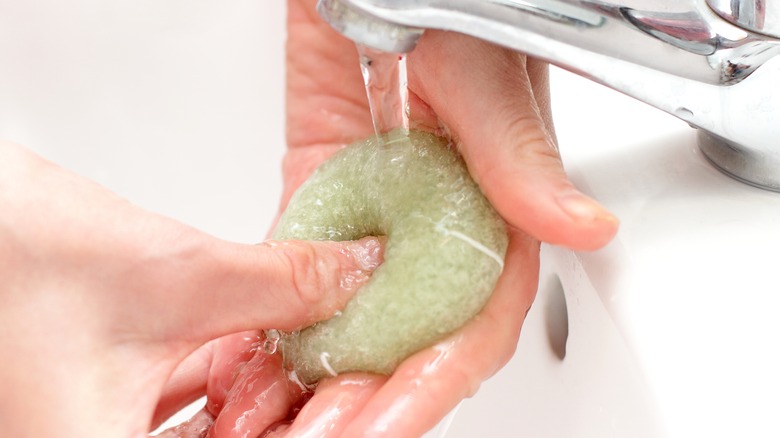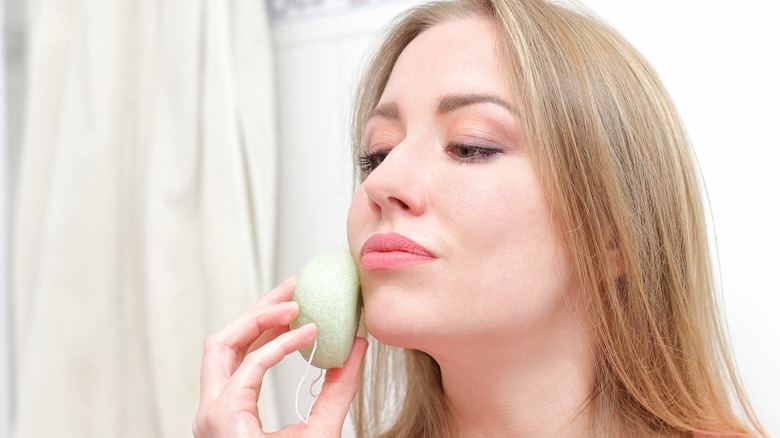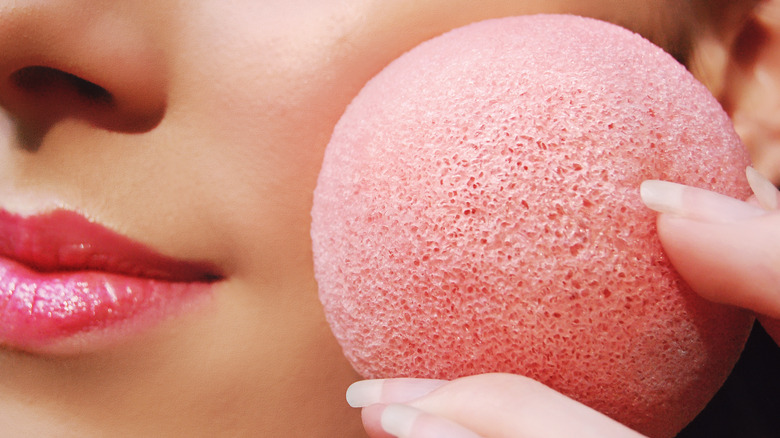What You Need To Know About Using A Konjac Sponge For Cleansing Your Skin
Sponges are generally better suited for dishes than your face, but konjac sponges are one exception — and once you start using one in your skincare routine, you might be hooked. A quick primer: Konjac is an edible root vegetable popular in Asia, and part of the same plant can also be used for making all-natural sponges. Unlike the cleaning tools you might find in your kitchen, these sponges are safe for your face. "Konjac sponges are made from a natural fiber that absorbs a lot of water, so it has a very unique texture, kind of like a thick piece of rubbery felt," Dr. Jessica Wu, a dermatologist and author of "Feed Your Face," explained to Refinery29. "It has more texture than a dish sponge, but it's softer than a loofah and has a finer texture than a washcloth, so it's safe to use on your face. Your skin will feel very soft and smooth, and makeup will go on better."
These skincare accessories might sound advanced, but really, they're completely low-tech. According to Healthline, you simply soften the sponge in water (otherwise, it'll be too rough), then use it with or without a face wash to massage the skin. However, konjac sponges aren't entirely foolproof — and using one the wrong way could wreck your complexion.
How to use a konjac sponge in your skincare routine
The add-water-and-maybe-soap protocol is fairly straightforward, but — like with any other beauty ritual — it's always a good idea to take extra precautions to protect your skin. When using a konjac sponge on your face, it's best to keep the sponge clean and away from anything you wouldn't want touching your face. Charlotte Connoley, a skincare expert and facialist, told Elle that the sponges should be rinsed, squeezed to expel excess water, and hung to dry after each use. Periodically, boil the sponge in water to kill any bacteria. Additionally, be sure to swap it for a new sponge every one or two months.
As for how often to cleanse your skin with a konjac sponge, there isn't a one-size-fits-all answer, though Dr. Adarsh Vijay Mudgil, founder of Mudgil Dermatology, confirmed to Healthline that daily use is generally A-OK. Try using your sponge as a natural makeup-nixing exfoliator before washing your face or as a cleansing tool paired with your go-to face wash.
One final note: Konjac sponges can be used on the body too, says Connoley via Elle. If you notice any rough or dead skin on your arms, legs, or other areas, gently massage a konjac sponge to exfoliate, just as you would on your face. To keep things hygienic, though, use a different sponge for your body than the one you use on your visage.
Are konjac sponges safe for all skin types?
Different skin types have different needs, but konjac sponges may be gentle yet effective enough to fit into almost any skincare routine — even if you're dealing with a finicky skin condition. People with acne might notice that konjac sponges help unclog pores, preventing future breakouts, shares Healthline. Sensitive skin folks may also find these made-from-nature beauty tools to be perfect for sloughing off dead skin without being too harsh. "They're more gentle than scrubs, so they're ideal for daily exfoliating," dermatologist Francesca Fusco revealed to Allure. "You can use them on sensitive skin, rosacea, and dry flakes that are difficult to buff away without irritating skin."
No matter your skin type, it's important to watch how your complexion responds after incorporating a konjac sponge into the mix. For instance, Dr. Sandy Skotnicki, a board-certified dermatologist, told Greatist that people with acne may suffer extra irritation if they use a konjac sponge too often. Similarly, Dr. Rita Linkner, a dermatologist at New York City's Spring Street Dermatology, also noted to Healthline that konjac sponges may damage super-sensitive skin. To err on the side of caution, try testing the sponge in one spot for a few days before using it on your entire face.
Different types of konjac sponges
In case you need more convincing that konjac sponges can work for almost any skin condition or concern, there are different types of konjac sponges infused with different ingredients. If you're not sure where to start, consider a basic sponge without anything added, or choose one that has properties suited to your skin type. "White clay is thought to balance pH level, pink clay is for sensitive skin, red clay is hydrating for dry skin, green clay is for combination skin, and black sponges have charcoal to draw out oils and impurities for acne-prone skin," Dr. Sonia Batra, a board-certified dermatologist and co-host of "The Doctors," shared with Greatist. Turmeric is another popular option, which some claim can create a brightening effect and fight signs of aging.
To give the ingredients time to work their magic, don't rush through the cleansing step of your skincare routine. Dr. Batra suggested using infused konjac sponges on the skin for at least 30 seconds so that the ingredients have time to lather up on your face.
Beware of over-exfoliation
If your skin is looking dull or congested, a konjac sponge can be a shortcut to some much-needed exfoliation. However, one downside of using the vegetable fiber on your face is that it could result in over-exfoliation. "Over-exfoliating is one of the biggest mistakes we see people making," Dr. Aanand Geria, a dermatologist with Geria Dermatology, explained to Healthline. "Generally, skin should be exfoliated only one to two times per week to help expedite skin cell turnover without causing damage." Your konjac sponge may be non-abrasive enough to override this rule, though you should still keep an eye out for signs of a damaged skin barrier from over-exfoliation, such as redness, irritation, or a waxy texture.
Additionally, you may want to cut back on other exfoliants when using a konjac sponge. Skincare brand Neutrogena warns against combining physical exfoliants (such as a sponge) with chemical exfoliants (AHAs, BHAs, or PHAs) in the same skincare line-up. However, you may be able to get away with alternating them, using a sponge to cleanse your face one day and an exfoliating serum, for instance, on another day.
The key takeaway: Konjac sponges are a natural, no-fuss way to cleanse and exfoliate the skin, but even they can come with some potential side effects. Listen to your skin, and cut back on the sponge massages if needed.




